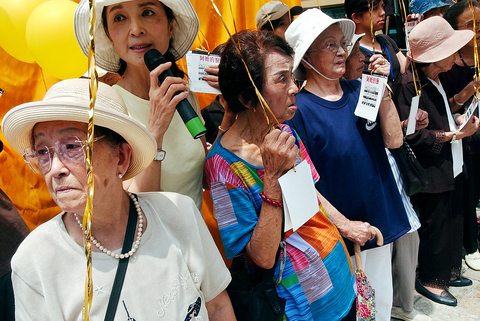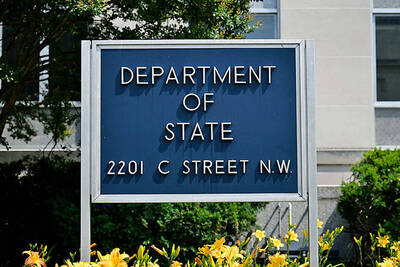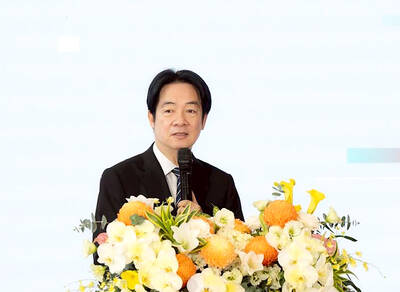Asia commemorated the 60th anniversary of Japan's World War II surrender yesterday by honoring the dead and searching for reconciliation, while Japan's leader tried to salve wounds by apologizing for the "great damages and pain" it inflicted on its neighbors.
With ceremonies and protests, the region memorialized the end to a conflict that killed millions of soldiers and civilians from the jungles of Burma to the glistening beaches of the Pacific and the sprawling cities of Japan and Korea.
Anger mixed with sorrow amid rekindled tension between Tokyo and the countries its Imperial Army invaded decades ago.

PHOTO: AP
Japanese Prime Minister Junichiro Koizumi expressed "deep reflections and heartfelt apology" for Tokyo's wartime colonization and pledged that his country would never forget the "terrible lessons" of the war, which ended Aug. 15, 1945.
"Our country has caused great damage and pain to people in many countries, especially our Asian neighbors, through colonization and invasion," Koizumi said in a statement. At a ceremony shortly thereafter, Koizumi and Emperor Akihito -- son of wartime Emperor Hirohito -- bowed before an alter of chrysanthemums at a nationally televised service for the nation's estimated 3 million war dead.
Japan's relations with some of its Asian neighbors are at the lowest point in years in part because of disputes about whether Japan has properly atoned for its past aggressions. The issue has contributed to opposition to Tokyo's bid for a permanent UN Security Council seat.
Fueling the grievances are Koizumi's controversial visits to Tokyo's Yasukuni shrine and his government's approval of history textbooks that critics say whitewash wartime atrocities such as the Rape of Nanking, in which Japanese troops massacred as many as 300,000 people while taking the Chinese city in 1937.
Tensions have also been stoked by disputes between Tokyo, Beijing, Taipei and Seoul over resource-rich islands off their coasts, and Japan's running argument with China over gas drilling in a contested area of the East China Sea. Concerns over communist North Korea's nuclear weapons program have also increased regional friction.
Protesters in Hong Kong, which Japan occupied from 1941-1945, marched on Tokyo's consulate yesterday, saying Japan had not sufficiently atoned for military aggression and chanting "Japan's hands are full of fresh blood." Scores of police meanwhile guarded Japan's Beijing embassy as China marked the anniversary demanding that Japanese leaders face up to suffering inflicted by their nation.
"Only with an honest attitude towards history can a nation win reconciliation and then integrate into the global community," the China Daily newspaper said. State television devoted the first 10 minutes of its midday news yesterday to war commemorations, showing battle scenes and the bodies of Chinese killed by Japanese troops.

MISINFORMATION: The generated content tends to adopt China’s official stance, such as ‘Taiwan is currently governed by the Chinese central government,’ the NSB said Five China-developed artificial intelligence (AI) language models exhibit cybersecurity risks and content biases, an inspection conducted by the National Security Bureau (NSB) showed. The five AI tools are: DeepSeek, Doubao (豆包), Yiyan (文心一言), Tongyi (通義千問) and Yuanbao (騰訊元寶), the bureau said, advising people to remain vigilant to protect personal data privacy and corporate business secrets. The NSB said it, in accordance with the National Intelligence Services Act (國家情報工作法), has reviewed international cybersecurity reports and intelligence, and coordinated with the Ministry of Justice Investigation Bureau and the National Police Agency’s Criminal Investigation Bureau to conduct an inspection of China-made AI language

BOOST IN CONFIDENCE: The sale sends a clear message of support for Taiwan and dispels rumors that US President Donald Trump ‘sold out’ the nation, an expert said The US government on Thursday announced a possible sale to Taiwan of fighter jet parts, which was estimated to cost about US$330 million, in a move that an expert said “sends a clear message of support for Taiwan” amid fears that Washington might be wavering in its attitude toward Taipei. It was the first announcement of an arms sale to Taiwan since US President Donald Trump returned to the White House earlier this year. The proposed package includes non-standard components, spare and repair parts, consumables and accessories, as well repair and return support for the F-16, C-130 and Indigenous Defense Fighter aircraft,

CHECKING BOUNDARIES: China wants to disrupt solidarity among democracies and test their red lines, but it is instead pushing nations to become more united, an expert said The US Department of State on Friday expressed deep concern over a Chinese public security agency’s investigation into Legislator Puma Shen (沈伯洋) for “secession.” “China’s actions threaten free speech and erode norms that have underpinned the cross-strait ‘status quo’ for decades,” a US Department of State spokesperson said. The Chongqing Municipal Public Security Bureau late last month listed Shen as “wanted” and launched an investigation into alleged “secession-related” criminal activities, including his founding of the Kuma Academy, a civil defense organization that prepares people for an invasion by China. The spokesperson said that the US was “deeply concerned” about the bureau investigating Shen

‘TROUBLEMAKER’: Most countries believe that it is China — rather than Taiwan — that is undermining regional peace and stability with its coercive tactics, the president said China should restrain itself and refrain from being a troublemaker that sabotages peace and stability in the Indo-Pacific region, President William Lai (賴清德) said yesterday. Lai made the remarks after China Coast Guard vessels sailed into disputed waters off the Senkaku Islands — known as the Diaoyutai Islands (釣魚台) in Taiwan — following a remark Japanese Prime Minister Sanae Takaichi made regarding Taiwan. Takaichi during a parliamentary session on Nov. 7 said that a “Taiwan contingency” involving a Chinese naval blockade could qualify as a “survival-threatening situation” for Japan, and trigger Tokyo’s deployment of its military for defense. Asked about the escalating tensions